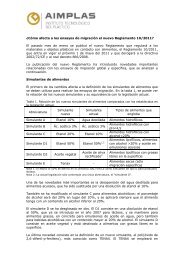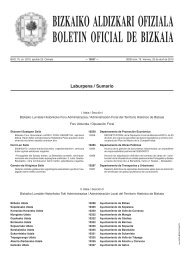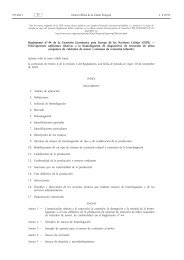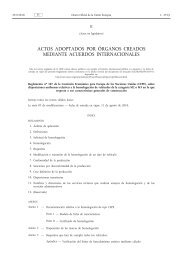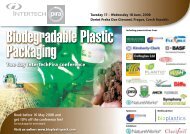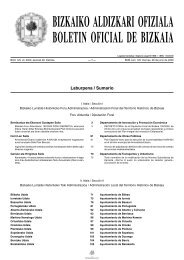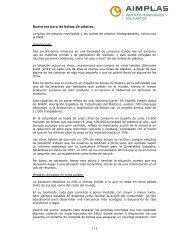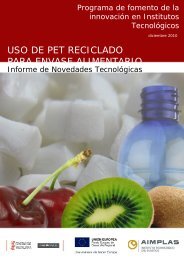Bitublock - Novel construction units composed of recycled waste ...
Bitublock - Novel construction units composed of recycled waste ...
Bitublock - Novel construction units composed of recycled waste ...
You also want an ePaper? Increase the reach of your titles
YUMPU automatically turns print PDFs into web optimized ePapers that Google loves.
<strong>Bitublock</strong> - <strong>Novel</strong> <strong>construction</strong> <strong>units</strong> <strong>composed</strong> <strong>of</strong> <strong>recycled</strong> <strong>waste</strong>materials and bituminous bindersThe increased demand for reuse/recycling <strong>of</strong> <strong>waste</strong> materials from national regulations and EUdirectives, as well as the issue <strong>of</strong> sustainable utilisation <strong>of</strong> primary materials and <strong>waste</strong> requires thecompliance from the <strong>construction</strong> sector. Therefore, the development and use <strong>of</strong> <strong>construction</strong>materials with high recycle content is considered essential.Trials investigated the production <strong>of</strong> bitumenous blocks using two different types <strong>of</strong> bitumen (50penetration bitumen and harder H 80/90 bitumen) and <strong>waste</strong> materials such as crushed glass,pulverised fuel ash (PFA), incinerated sewage sludge ash (ISSA) and steel slag. The properties <strong>of</strong> theused materials can be seen in Table 1.In <strong>Bitublock</strong>, the use <strong>of</strong> bitumen as the binder managed to achieve a level <strong>of</strong> replacement that exceedsany replacement percentage achieved so far with cementitious and clay-bound materials.Table1: Materials used in <strong>Bitublock</strong> mixturesMaterialsDensity(Mg/m 3 )Waterabsorption%Utilisationcrushed glass 2.51
25% IBA100% CG4% FA 5 (50 pen) 100/24 2.027 12.1 4.475% CG100%100% CG4% ISSA 16 (50 pen) 100/24 1.748 12.4 8.1ISSA100% SS (*2) 100% CG 4% FA 5 (H 80/90) 160/24 2.452 12.8 9.8(*1): CG= crushed glass, (*2): SS= steel slag, (*3): FA= fly ashThe compressive strength <strong>of</strong> the various versions <strong>of</strong> <strong>Bitublock</strong> is at least equal to that <strong>of</strong> thecurrent normal aggregate block produced in UK (at least 3.5 - 7.0 MPa). <strong>Bitublock</strong>s provide anideal opportunity for the utilisation <strong>of</strong> many <strong>waste</strong> materials. The combination <strong>of</strong> different <strong>waste</strong>sdoes have an effect on the overall performance and properties <strong>of</strong> the block. However, the differentproperties highlight the flexibility <strong>of</strong> the new unit to match different practical requirements. Formore information contact:Dr. John Forth School <strong>of</strong> Civil Engineering, University <strong>of</strong> Leeds, LS2 9JT, Leeds. Tel: 01133432270 Email:j.p.forth@leeds.ac.ukDr. Dong Van Dao, School <strong>of</strong> Civil Engineering, University <strong>of</strong> Leeds, LS2 9JT, Leeds. Email:cenvdd@leeds.ac.ukPublications:FORTH, J. P., ZOOROB, S. E. & THANAYA, I. N. A. (2006) Development <strong>of</strong> bitumen-bound <strong>waste</strong>aggregate building blocks. Proceedings <strong>of</strong> the Institution <strong>of</strong> Civil Engineers - ConstructionMaterials, 159, 23-31.VAN DAO, D., FORTH, J. P. & ZOOROB, S. E. (2006) Bitumen bound <strong>construction</strong> <strong>units</strong> utilisingonly <strong>recycled</strong> and <strong>waste</strong> materials as aggregates. 5th International Conference on Research andPractical Applications Using Wastes and Secondary Materials in Pavement Engineering. JohnMoores University, Liverpool



